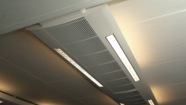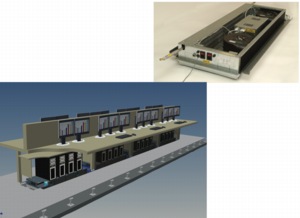Cool thinking at Trox

By rethinking how primary air induces secondary air in active chilled beams, Trox has doubled cooling capacity — or enabled the primary air required to be halved.
You cannot avoid cooling in many buildings, so it is important to deliver that cooling with the minimum use of energy — which is what recent developments by Trox achieve.However much design expertise is applied to eliminate or, at least reduce, the need for cooling in buildings, there will still be many occasions when cooling is required — especially where internal heat gains are very high, such as in an IT-intensive environment. Accepting that the need for cooling cannot be designed out, it is important that cooling is delivered effectively and efficiently. That is a principle that has driven Trox’s development programme in the UK for many years — resulting in the continuing development of chilled beams and its CO2OLrac approach to removing heat from equipment racks in IT rooms using a carbon-dioxide-based cooling system. The latest developments see a doubling in the cooling capacity of active chilled beams and the application of CO2 cooling to dealing rooms, where individual traders have several PCs providing a wealth of information for their financial activities.
Chilled beams The latest enhancement to chilled beams enables their energy use to be halved or, conversely, the cooling capacity to be doubled. Active, or induction, chilled beams use the introduction of primary are through nozzles to induce room air and pass it over cooling coils before it is returned to the room. In such a beam, 1 m3 of primary air might entrain 4 m3 of secondary air, an induction ratio of 4:1. They key to delivering more cooling or using less energy is to increase the induction rate. By replacing downward-pointing plastic nozzles with aerodynamically shaped holes punched directly in sheet metal, Trox has doubled the induction ratio to 8:1. With modern production machinery, it is very easy to change the shape, size and spacing of these holes to maximise performance. Trox in Germany undertook a comprehensive 6-month programme of testing and development to discover the optimum combination of shapes, diameters, discharge direction and spacing for maximum performance. Three nozzle sizes have been chosen to satisfy the most stringent project design requirements.
CO2 cooling The other recent development is the application of CO2 cooling to remove the huge quantities of heat produced by PCs in dealer rooms. So much heat can be produced that it is impossible to deal with it simply by cooling the air in the room. These computers are integrated into workstations, and there are several per workstation — so that the temperature in footwells can get very high. The concept has already been used in a dealing room in London operated by JP Morgan, with heat loads of 720 to 900 W per trading desk. CO2OLdesk, as the concept is called, removes heat directly from the desk chamber housing the PCs so that it does not enter the room itself. About 350 units serve trading desks over two floors at 100 Wood Street. Not only is the cooling requirement met, but Trox says that it is achieved with 30% less energy use than chilled-water alternatives. Heat is removed from the PC enclosure by the partial evaporation of liquid carbon dioxide at 14°C. The flow and return temperatures are both 14°C, and the evaporated carbon dioxide can be condensed using conventional chiller plant. Because heat is removed from trading desks themselves, a dealing room could have more desks. A range of cooling units has been developed.
 |
Rather than have heat from PCs serving traders’ desks in dealing rooms escape into the room itself, Trox has developed its CO2-based approach for removing heat from IT racks to remove heat at source. |
One is a 200 mm-deep recessed unit with a cooling capacity of 1500 W that replaces 600 mm-wide floor tiles and finishes flush with floor level. A 150 mm-deep unit with a cooling capacity of 1200 W sits partially within and partially above the floor. Finally, a 120 mm-deep unit with a cooling capacity of 120 W is designed to fit directly onto the raised floor; it is well suited to retrofit installations, as desks can remain in place during installation. Reliability is very important in cooling rooms, so each unit has two power supplies and two fans. If one fan fails, the other can meet 75% of the load, which should satisfy most situations if load diversity is considered. CO2OLdesk was developed for a particular project, but it is perceived by Trox as having the potential to enable low-specification office space to be converted to dealing rooms.
Production investment Continuing development by Trox, especially its multi-service chilled beams, has put considerably pressure on its manufacturing capability at Thetford. In response to increasing demand, Trox has invested nearly £2 million in technology that will revolutionise the manufacture of its products and allow lead times to be slashed from days to hours. The flexibility of the manufacturing cell enables batch sizes to be reduced to one. One impressive piece of equipment is a Trumpf machine for punching sheet metal, including stainless steel and aluminium. It can process sheets up to 8 mm thick with up to 1200 strokes/min to an accuracy of better than ±0.1 mm. This automatic machine is served by robot technology that can automatically place sheets up to 2.6 x 1.3 m into the press and remove and stack finished parts. Tools in the press are changed automatically in less than 3 s by a robot arm that selects from an extensive carousel.
Related links:
Related articles:




